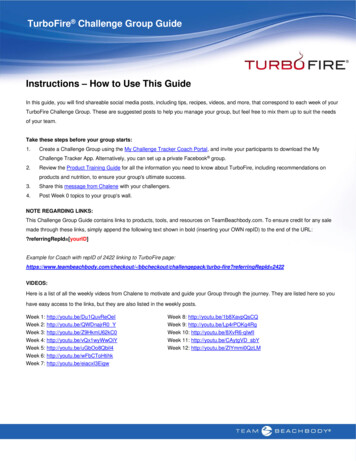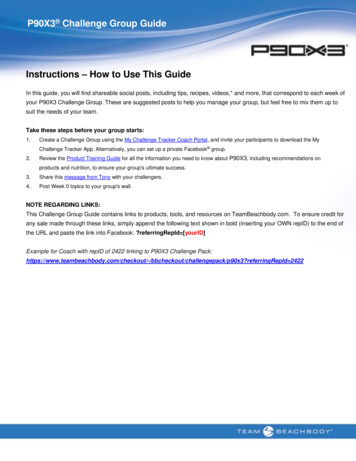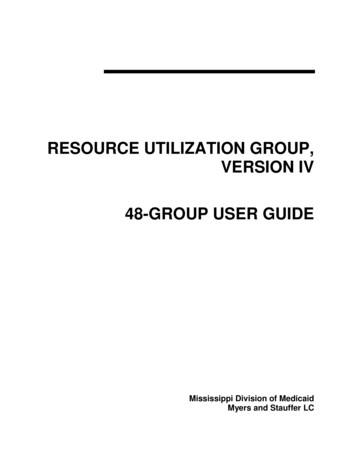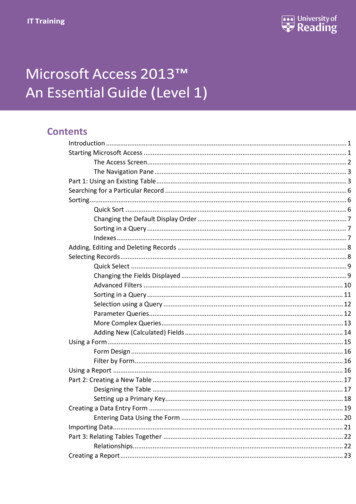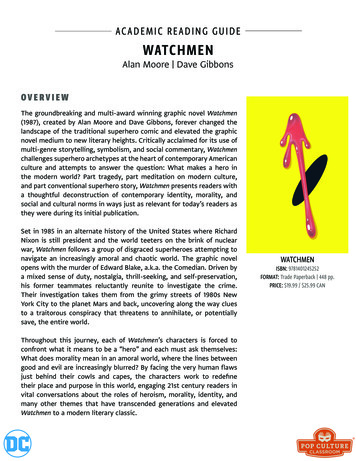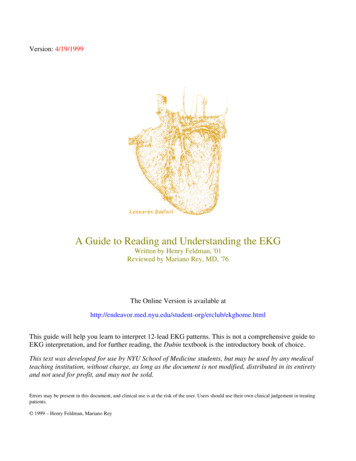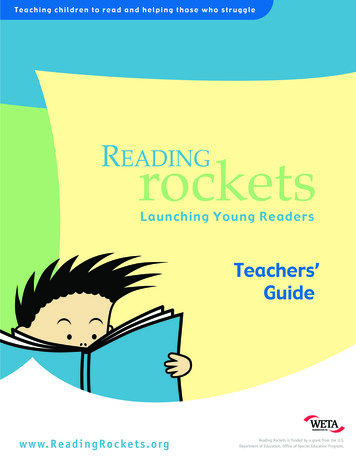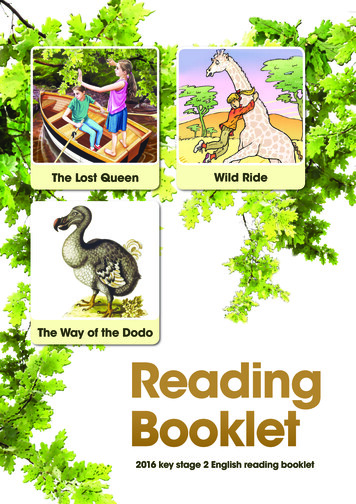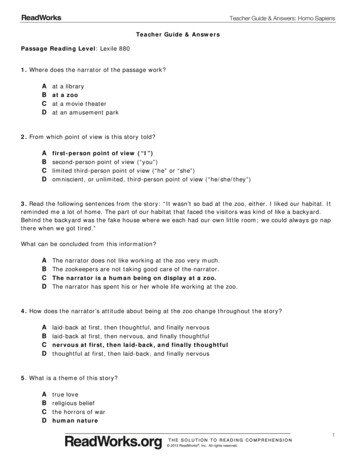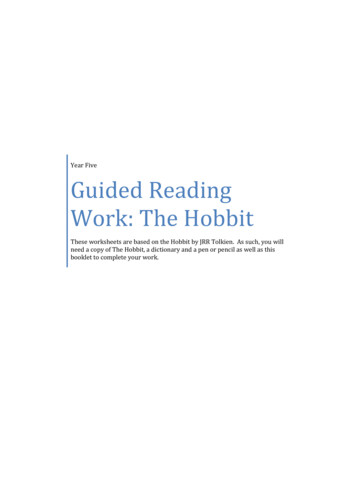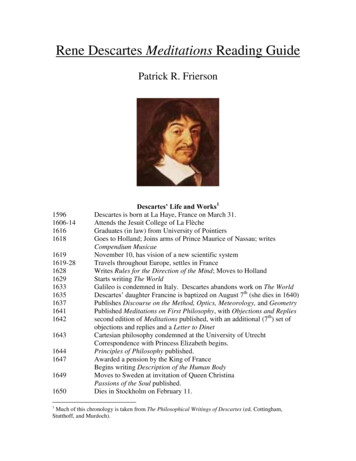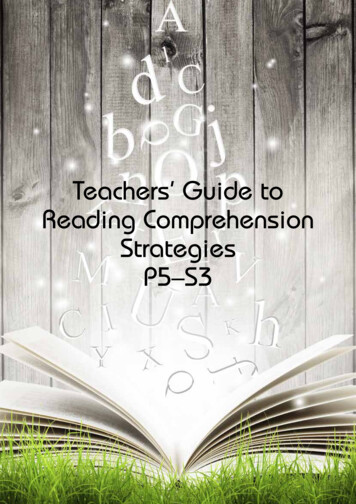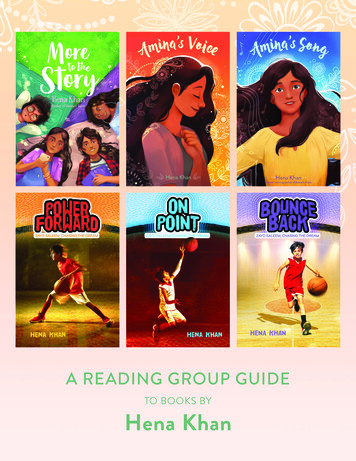
Transcription
A READING GROUP GUIDETO BOOKS BYHena Khan
A READING GROUP GUIDE TOMore to the StoryHC: 9781481492096PB: 9781481492102Ebook: 9781481492119Ages 8–12Lexile 710LF&P Text Level Gradient VBackground/SummaryHena Khan offers middle grade readers a modern story inspired by the classic novel Little Women. When a work contracttakes their father overseas for six months, the Mirza sisters—Maryam, Jameela, Bisma, and Aleeza—find their lives changedunexpectedly. Jameela, an aspiring journalist, wants to find the perfect subject for her next school newspaper article: one thatwill make her father proud and position her to become senior editor next year. But when her latest story threatens to end anew friendship with Ali, a boy from England with a charming accent and sense of humor, and her beloved younger sisterbecomes dangerously ill, she discovers that there is more to the stories she wants to tell.Discussion Questions1. Describe the relationships that the Mirza siblings have with their parents and one another. Which sisters are theclosest? Which sisters have conflicts? How does each sister relate to their mother and father? Explain the ways that therelationships in the book are similar to and different from relationships you have with your parents, siblings, or othersyou live with.2. Why does Baba have to be away from home? Have you ever had to be separated from someone close to you, like aparent or sibling? What did you do to stay in touch? How did the distance affect your relationship?3. How do the characters in this book encourage one another? Why do you think it’s important to support and encourageothers?4. Jameela says, “That’s why social media is messed up. It makes you worry about what you’re not doing, or lets everyoneelse know what they’re not doing. And then you can’t enjoy what you’re doing now.” Explain why you agree or disagreewith this statement. Can you identify any positive uses of social media in the book?5. What advice does Jameela’s mother give her about handling her emotions? How does Jameela’s temper cause hertrouble? Are you quick to show anger like Jameela, or do you have a different way of dealing with things that bother orupset you? What advice have people given to you?6. Why is Jameela offended by Kenzie’s and Maureen’s comments that she’s good at archery because she’s “Indian”?Do you think Kenzie and Maureen were trying to be offensive? Do you think Jameela, Kenzie, and Maureen handled2
this situation correctly? How would you respond if you realized you had unintentionally offended or hurt someone’sfeelings?7. Jameela’s parents don’t want their daughters to worry about the family’s finances, so they try to protect them fromfinding out too much. Do you think parents or guardians should be open with their children about things like financialchallenges, or is it better for them to keep these problems to themselves?8. Why does Ali refuse to contribute to Jameela’s newspaper article about microaggressions? Why do you think he reactsthe way he does when she tells him that she wants to change the focus of the article? How would you have handledthe situation if you were Jameela?9. Travis and Jameela have to work together on the school newspaper even though they disagree about many issuesrelated to journalism. How do they learn to work together? How have you dealt with disagreements with a partner on agroup project or other activity? Why is it important to work with people who have ideas that are different than yours?10. What does Jameela help Ali realize about the reason he has given up playing soccer?11. Why was it wrong for Jameela to include Ali’s anecdote in the article she published on microaggressions? In chapterthirty-five, Ms. Levy discusses the ethical rules of journalism with her students. Identify these rules and explain whyeach one is important.12. Aleeza feels like she should be allowed to have a phone even though she is not yet thirteen, which is the age that Jameelaand Maryam received their phones. Do you agree or disagree with her reasons for wanting a phone? How would youmake an argument for receiving your first phone? What responsibilities come with having one? Explain your answers.13. How does Bisma’s illness bring the Mirza family closer together? Why do you think it can sometimes be difficult toask for help?14. Do you think that Ali and Jameela feel the same way about each other? How do you know? Explain your answers.15. Why does Jameela decide to shave her head? How do you think her gesture made Bisma feel?16. Jameela’s article is about microaggressions, which are comments or actions based on stereotypes or prejudices that areintentionally or unintentionally insulting. The media often perpetuates stereotypes in the way it portrays people andcommunities. How does Hena Khan’s book challenge stereotypes about Muslim families? Why do you think books thatchallenge stereotypes are important?17. One of Jameela’s characteristics that helps her to write well is her ability to view others with empathy. How does shedemonstrate empathy toward Bisma? Why is empathy especially important for a journalist?Extension Activities1. Jameela wants to publish a digital version of the paper rather than continuing to print paper copies. Work with a groupto write and publish an edition of a class or family newspaper. Before you begin writing, debate and decide whether youwant to publish a physical or digital newspaper, and the merits of both. Each group member should choose a story towrite, keeping in mind Ms. Levy’s ethical rules of journalism. Make sure you’ve chosen diverse content in various stylesand formats that showcases your group’s personalities!2. Hena Khan’s novel is inspired by Louisa May Alcott’s 1868 novel Little Women. Read Alcott’s novel or watch a filmadaptation of the book, and create a chart comparing characters and plot elements in More to the Story and Little Women.Does seeing the parallels give you a deeper understanding of any of Hena Khan’s characters or their motivations?3. When Bisma is diagnosed with cancer, her friends and family create a support network for her. Research an organizationor event that supports cancer patients, survivors, and their families. Some research possibilities include Relay for Life,St. Baldrick’s Foundation, Light the Night, Rally for the Cure, CaringBridge, Beads of Courage, and the Make-A-WishFoundation. Deliver a presentation about the organization you’ve selected, including ideas about how you or your3
classmates can get involved. Why do you think communities like this are so important?4. Research microaggressions, including what they are, why they matter, and how to avoid them. With your newfoundknowledge, create an awareness campaign that encourages your school community to be mindful of the words theyuse. Develop a slogan, a poster image, and a call to action.5. Jameela considers the role of English classes and an after-school writing club in fostering her love of journalism andher friendship with a fellow writer, Lily. Create your own piece of creative writing, inspired by More to the Story. Youmay want to write a short story that imagines where one or more of the characters will be five years after the end ofthe novel, or rewrite a scene in the book from a different character’s point of view. You may even want to try writing acontemporary retelling of a classic story.6. One article that Jameela proposes for the paper is a debate about whether or not schools should ban football. Researchthis issue, and then divide into two groups for a class debate about this controversial topic.7. Baba’s career takes him away from his daughters as he travels overseas with a short-term contract for work in AbuDhabi. Locate Abu Dhabi on a map or globe and research some key locations and facts about Abu Dhabi and theUnited Arab Emirates (UAE). Then create a travel guide for Abu Dhabi that includes information about local currency,transportation, climate, places to see, food, and culture.4
A READING GROUP GUIDE TOHC: 9781481492065PB: 9781481492072Ebook: 9781481492089Ages 8–12Lexile 800LF&P Text Level Gradient UAwards & Honors: ALA Notable Children’s Books CCBC Choices (Cooperative Children’s Book Council) CBC/NCSS (Notable Social Studies Trade Book) Texas Bluebonnet Master List South Asia Book Award Highly Commended Title NCTE Charlotte Huck Outstanding Fiction Recommended TitleBackground/SummaryThe first year of middle school is tricky. Suddenly, Amina’s best friend, Soojin, starts talking about changing her name and,even worse, spending time with Emily—a girl that used to make fun of them! Amina’s older brother seems to be getting intoa lot of trouble for his grades, and now he wants to play basketball instead of studying. To make matters worse, her unclecomes to visit from Pakistan, and her parents seem to be trying awfully hard to impress him. With so many changes, it’s hardto know how to be a good friend, sister, and daughter. But when Amina’s mosque is vandalized, she learns that the thingsthat connect us will always be stronger than the things that try to tear us apart.Discussion Questions1. Describe Amina’s feelings about music. What keeps Amina from telling her teacher that she would like to sing asolo? What could Amina do to overcome her fear? Have you ever been afraid to do something you wanted to do?What happened?2. Why does Soojin consider changing her name? Why do you think Amina is uncomfortable with the idea of Soojinchanging her name? Have you ever wanted to change your own name?3. Why do you think Emily decides to stop being friends with Julie and to start being friends with Soojin and Amina?Why doesn’t Amina trust her at first? How would you react if someone who had been mean to you in the past tried tobecome your friend?4. What causes tension between Amina’s parents and her brother? How do they resolve their differences? Have you everwanted to do something your parents did not want you to do? Have your parents ever required you to do somethingyou did not want to do? How did you handle the situation?5. How is Thaya Jaan related to Amina? How can you tell that Amina’s parents respect Thaya Jaan? What do they agreeabout? What do they disagree about?6. Why is Amina initially unhappy with the group she is assigned to work with on her class Oregon Trail project? What isthe best thing about working with a group? What is the hardest thing about working with a group? What does Aminalearn from working with Bradley, Soojin, and Emily?5
7. Describe what happens at Amina’s Sunday school. Do you attend any religious services or classes? If so, how isAmina’s experience similar to yours? How is it different?8. Both Amina and Soojin have been teased because of the food they bring to school or the way their food smells. Whydo you think people tease or bully kids who are different? If you were in Amina or Soojin’s position, how would yourespond? If you encounter someone from a different cultural background, how should you respond to them?9. Discuss the role that forgiveness plays in the novel. Who does Amina need to forgive? Whom does she need to ask forforgiveness? Do you think it is more difficult to ask for forgiveness or to forgive someone else?10. How does jealousy threaten Soojin and Amina’s friendship? What does Amina learn about Soojin, Emily, and herselfas a result? Do you think Soojin is a good friend to Amina? Is Amina a good friend to Soojin?11. In the novel, Amina is trusted with secrets. Do you think she’s right to keep Mustafa’s secret? Should she have keptEmily’s secret? Why is it sometimes hard to keep secrets? Are there ever secrets that you should not keep?12. Amina’s parents and Thaya Jaan disagree about whether or not music is forbidden. In every family, people disagree aboutthe way to raise children and about what types of behavior should be allowed. How does Amina navigate the conflictingviewpoints in her own family? Have you ever had to navigate a similar situation? If so, how did you handle it?13. What is backbiting? Why does Amina feel guilty of backbiting? In your opinion, did she backbite Emily?Explain your answer.14. Amina’s parents are concerned that Thaya Jaan will not be happy when he visits because, as they say, “You know there’ssome bad feeling in this country toward Muslims, and all this negative talk in the news these days.” When Thaya Jaanis in America, what evidence of bad feelings toward Muslims does he witness? What good things about America andacts of kindness does he witness? What does he conclude about life in America?15. What is vandalism? How did the description of the vandalism of Amina’s mosque make you feel? How do you thinkyou would feel if your school or place of worship was vandalized? Explain how this act of violence ends up bringingAmina’s community together.16. The novel ends with a message of change. In literature, characters that change are called dynamic characters. Almost allthe characters in Amina’s Voice are dynamic characters. Explain how each character changes.Extension Activities1. The characters in Amina’s Voice have different cultural backgrounds. Amina’s family is from Pakistan, Soojin’s family isKorean, and Emily’s grandmother was Polish. Research the cultural background of a character in the novel or researchyour own family’s cultural heritage and participate in a multicultural celebration where you present your research toyour class.2. Amina’s Voice includes vocabulary and references to Islamic and Pakistani culture. Choose an unfamiliar vocabularyword and research what it means. Working with your classmates, create a word wall for the book.3. Food plays an important role in both Soojin and Amina’s families. Research the food of Pakistan or Korea and trycooking a traditional dish at home or eating in a Korean, Indian, or Pakistani restaurant to sample one of the foods thatKhan writes about (ex. kimchee, masala chai, naan, gulab jamun, or bulgogi). Write a food review of the dish or dishesyou sampled, including a recipe so that your classmates can try the food at home if they wish.4. One of the conflicts that Soojin must resolve is the question of whether or not to change her name. Ask your parentsthe story behind your own name. How did they select it? What does your name mean?5. After Amina’s mosque is vandalized, Soojin’s church volunteers to host the Islamic Center’s carnival and Qurancompetition. What common values bring these communities together? Why is it important for people of differentfaiths and cultural backgrounds to be kind to one another and work together?6
6. Amina is given a class project to compete with her classmates in a game called The Oregon Trail. What was the OregonTrail? With a group of classmates, play this game and see how you do as settlers. The original version of the game isavailable for free online, but it has also been reimagined as both an app and a card game. What did playing this gameteach you about working together?7. In Sunday school, Amina hears the story of Prophet Yusuf and his jealous brothers. How is this story similar to thestory of Joseph and the coat of many colors? Examine another story, such as the story of the great flood or a folktalelike “Cinderella” or “Beauty and the Beast” that has different versions in different cultures.8. Amina chooses the classic Sam Cooke song “A Change Is Gonna Come” to sing at the concert. Look up the lyrics andresearch the history of the song. What inspired Cooke to write the song? Why do you think the song became knownas an anthem of the civil rights movement? Why do you think Amina relates to this particular song?9. Throughout the book, the author uses figurative language to describe Amina’s feelings. For example, Amina describesjealousy as “a fresh shock.that courses through my veins like I had stuck my pen in an electrical socket.” Using Amina’sdescriptions as a model, write a list of similes that describe the way different emotions feel.10. Soojin and her family are very excited about becoming American citizens. Research the pathway to American citizenship.How difficult is it to become a United States citizen? What happens at a naturalization ceremony? If you have a familymember that has gone through the naturalization process, ask them what it was like. Did they do anything special tocelebrate the ceremony?11. After the mosque is vandalized, Imam Malik says, “Muslims have far more friends than enemies in this country. Somepeople don’t understand Islam or are misled and fear us. But I’m getting so many calls of support from our friends andneighbors in the community.” One quality that makes America special is the fact that we are welcoming of differentcultures. What steps can your class or community take to support and be kind to one another and to people fromdifferent cultural backgrounds?12. Imagine this book as the first part of a series. What do you think is next for Amina, Soojin, Emily, and Mustafa? Createa book jacket for an imagined sequel to Amina’s Voice. Include a brief synopsis of your imagined sequel.7
A READING GROUP GUIDE TOAmina’s SongHC: 9781534459885Ebook: 9781534459908Ages 8–12Background/SummaryAmina’s Song picks up after Amina’s Voice leaves off; these books can be read in any order as companion novels. As Aminaprepares to enter seventh grade, she becomes more aware of navigating her dual identities as an American and a Pakistanigirl. A summer trip to visit her uncle Thaya Jaan and extended family in Pakistan opens her eyes to the rich culture ofher family’s homeland, sparking a desire to share her culture with her friends and classmates in America and to counterstereotypes. Music provides the answer that she’s looking for, but this time around, she won’t use her voice to sing a songwritten by someone else; with the help of her new friend Nico, she will share her own unique song with the world.Discussion Questions1. Before you begin reading, brainstorm everything you know or think you know about the country of Pakistan. Next,make a list of things you want to know about Pakistan. After you finish reading, look back at your list. Were the thingsyou believed you knew correct? What did you learn about Pakistan by reading Amina’s Song? What are you still curiousto know?2. Why was Amina initially nervous about visiting Pakistan? Explain how her experience in Pakistan was different fromwhat she expected.3. Amina remembers her father explaining the difference between rational and irrational fear. Why is it important torecognize this distinction? How can you tell the difference? Can you give examples from your own experiences or fromthe novel?4. Why does Amina want her classmates and friends in America to see Pakistan the way she sees it? Why is she happywhen she learns that America is helping to preserve a World Heritage Site in Pakistan?5. Why do you think Amina is emotional when it comes time for her visit to Pakistan to end? Can you relate to howAmina feels when she says goodbye to her uncle, aunts, and cousins? What experience of your own comes to mind?6. Amina and her cousin Zohra have very different approaches to bargaining with the street vendors at the market inPakistan. Describe the differences in the ways they approach their roles as customers. Do you think you would be morelike Zohra or Amina in a similar situation?8
7. Explain how seeing the little boy asking for money in Pakistan impacts Amina. How does she turn this sense ofempathy into action to help others once she returns to America?8. When she is on the plane returning to the United States, Amina wonders if her brother is “as mixed up as I am, as wetravel not only through time zones but also from one part of our lives to another.” Why does leaving Pakistan causeher to feel this way? Do you have a place that is so important to you that it feels like it is a part of you? Explain youranswers.9. Why does Soojin decide to run for student body president? What sets her campaign apart from her competitors? Haveyou ever considered running for student government? Explain your answers.10. What does Amina realize about Rabiya’s feelings toward her friendship with Zohra and her trip to Pakistan? What doyou think might have happened if Amina had gotten angry with Rabiya instead of considering how Rabiya might befeeling? What actions does she take instead, and how does her response toward Rabiya impact their relationship?11. Toward the end of the book, Amina reflects, “even if my friends can’t understand everything I’ve been going throughlately, they’re trying. And we can support each other while we do different things.” What steps does Amina take tomaintain her friendships with Emily and Soojin? Why do you think some friends grow apart while others remain? Canyou learn anything from Amina, Soojin, and Emily about how to be a good friend?12. Why does Amina choose to research Malala for her history project? Explain why sharing her preliminary researchmakes Amina worry that she’s chosen the wrong person to profile. How does Amina solve this dilemma? Why do youthink her teacher calls her decision “brave”?13. All the seventh-grade students participate in a Living Wax Museum project, where they research, dress as, and presentreports on a historical figure. You may have participated in a similar project in the past. If so, whom did you choose asyour historical figure? Reflect on your reasons for selecting them and what you learned. If you have never participatedin this activity, whom would you select to research and impersonate? Why would you choose them?14. One of Amina’s strengths is her ability to consider what other people might be thinking or experiencing and how theymight feel. Read the last paragraphs of chapter eleven. What can you learn from Amina’s example? How does havingand practicing empathy change the way a person interacts with other people?15. What is the difference between primary sources and secondary research sources? Why is it important to look at avariety of different sources when you are gathering information? What can happen if you only use one source or onetype of reference source in your research?16. Amina is frustrated by her friends’ and family’s assumptions that she is romantically interested in Nico. She reflects,“But maybe I want to be friends with a boy without everyone assuming he’s my boyfriend.” Have you ever been ina situation like Amina? Do you think that it’s harder for boys and girls to be friends as they get older? Explain youranswers.17. Describe the special bond that Amina has with her uncle, Thaya Jaan. Do you have a family member whom you feelparticularly close to? What interests or activities brought you together?Extension Activities1. This book is a companion novel to Amina’s Voice. Read both books and consider how Amina’s character developsthroughout. Identify events in the first book that are significant to her character’s development, and discuss how theseevents impact her in the second book. For example, in the first book, Amina’s mosque is vandalized, an event that isalluded to several times in Amina’s Song. How does this continue to impact the way Amina feels and responds to others?2. Children like Amina, who grow up in between two cultures, are sometimes referred to as “Third-Culture Kids” orTCK, a term that recognizes the impact of growing up in a culture different from a parent’s culture. Amina describesthis sensation when she says, “I can’t help feeling like an impostor or a shapeshifter who appears to be a regular9
Pakistani girl on the outside but doesn’t know how to act like one.” Research the concept of third-culture kids, andthink about Amina’s experiences in the book. Then write an essay considering the following questions: What uniquechallenges might TCKs face? What are the benefits of being a TCK? Alternatively, if you identify as a TCK, write anessay sharing and reflecting on some of your experiences. Then participate in a class or small group discussion aboutwhat most surprised you or what you felt were the most important conclusions in your essay. What can you do to makeyour classroom or community more welcoming or inclusive? What kinds of things would you like to learn about yourclassmates?3. Amina documents her trip to Pakistan by taking photos and videos. Journaling gives her another way to preserve hermemories, and she is eventually able to create a song and video about her trip. Look back at photos and videos of aspecial day or memorable trip and then write down your memories and reflections about what the experience meantto you; if you don’t have these items, consider talking to the people who were with you to remember some of yourfavorite parts about the experience. As Amina says, “All the memories, funny moments, and unforgettable scenes livinginside me, things I’ve been thinking about and writing about in my notebook, are parts of me.” Use your memories tocreate a song, collage, video, webpage, slideshow, poem, podcast, or even a narrative essay to document and share thispart of your life with others.4. Amina finds herself drawn to the music of Nusrat Fateh Ali Khan, a musician who performed in a traditional Pakistanistyle known as Qawwali. Research this style of music and explain the cultural significance of Qawwali. Choose oneQawwali song and analyze the lyrics. Can you think of any Western songs that have similar themes or messages? Whydo you think this music resonates so strongly with Amina?5. Soojin’s cousin inspires her to run for student government by telling her, “‘we can’t afford to sit on the sidelinesbecause we’re the next generation of leaders.’” Work with a small group to discuss a local, national, or global problemthat you would like to help tackle, and brainstorm ways to make a difference through community service.6. When Amina is anxious or upset, she often gets a stomachache. Research the different ways anxiety can impact physicalwell-being, and find strategies to help deal with it. Present your findings in an informational poster or flyer to help raiseawareness about best practices for managing and talking about mental health.7. Amina describes her feelings by saying, “It’s like a piece of me was left in Pakistan, and I wonder when I’ll be wholeagain.” When she shares this with her friends, she finds out that Soojin hasn’t visited Korea in years, and her friendEmily misses her summer camp. Write a descriptive essay about a place that is important or meaningful to you. Try todescribe it with the same level of detail that author Hena Khan uses to describe Pakistan, making sure to use imageryor words that appeal to each of the five senses to help your reader picture the place you describe.8. Amina’s family works with their faith community to help refugees get settled in America. How do different members ofthe community contribute? Why is it important to make people feel welcome? Choose one of the following projects:Research local or national organizations that help refugees, and share ways your classmates can help.Develop a plan for ways that your school can formally welcome transfer students, help them make friends, andadjust to a new school.9. Nico teaches himself and then Amina how to use music-editing software on his laptop. Most computers, phones, andtablets have access to programs for music composition and editing. Using a photo or group of pictures as inspiration,try composing a short piece of music about your memory. Consider the way that different sounds, beats, and melodiescan reflect emotions. You can choose to include lyrics in your song, or you can make it instrumental.10
A READING GROUP GUIDE TOZAYD SALEEM, CHASING THE DREAM#1: Power Forward#2: On Point#3: Bounce BackHC: 9781534411982 PB: 9781534411999HC: 9781534412026 PB: 9781534412019HC: 9781534412057 PB: 9781534412040Ebook: 9781534412002Ebook: 9781534412033Ebook: 9781534412064Ages 7–10; Grades 2–5Ages 7–10; Grades 2–5Ages 7–10; Grades 2–5Lexile 600LLexile 650LLexile 680LF&P Text Level Gradient QF&P Text Level Gradient QF&P Text Level Gradient QThese questions and activities can be used with Power Forward and On Point.Background/SummaryFourth grader Zayd Saleem is not just going to be a professional basketball player. He’s going to be a star—the first PakistaniAmerican kid to make it to the NBA. However, life can get complicated, especially when your dreams are different from theplans your family has for you. Zayd has a loving and close-knit family, but what his parents want him to do (and eat) is notalways the same as what he wants for himself. After his favorite uncle, Jamal Mamoo, helps him learn to stand up for himself,it’s his turn to be a leader and help his best friend, Adam, and Uncle Jamal to follow their dreams as well.Discussion Questions1. Make a family tree for Zayd, including a description of each member of his family. Can you relate to his relationshipswith his mom, dad, sister, uncle, or grandparents? How is his family similar to yours? How is it different?2. How does Zayd respond to stress and anxiety? Do you think there is anything that seems to help him when he is feelinganxious? What do you do when you are anxious or worried about something?3. Why do you think Zayd’s parents want him to continue to play the violin? Have your parents ever wanted you to dosomething that you didn’t want to do? How did you handle it?4. How does Zayd initially deal with the conflict between his desire to focus on earning a spot on the gold team and11
his parents’ wish for him to pursue orchestra? How does his mother find out that he has stopped going to orchestrapractice? What lesson does he learn from his mistake?5. Zayd has a very close relationship with his uncle, Jamal Mamoo. How does Jamal encourage Zayd? Why is it importantto have an adult in your life whom you can trust?6. Zayd comes from a Pakistani American family. What cultural traditions do they have that are different and similar fromyour family’s traditions?7. Three generations
Each group member should choose a story to write, keeping in mind Ms. Levy’s ethical rules of journalism. Make sure you’ve chosen diverse content in various styles and formats that showcases your group’s personalities! 2. Hena Khan’s novel is inspired by Louisa May Alcott’s 1868 novel Little
